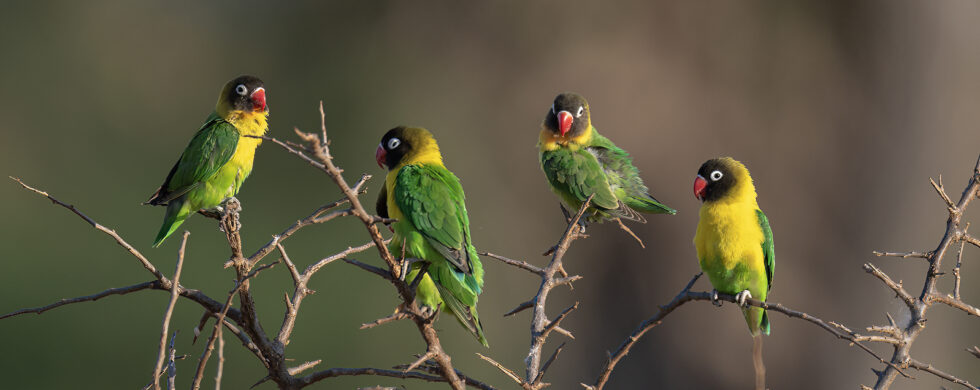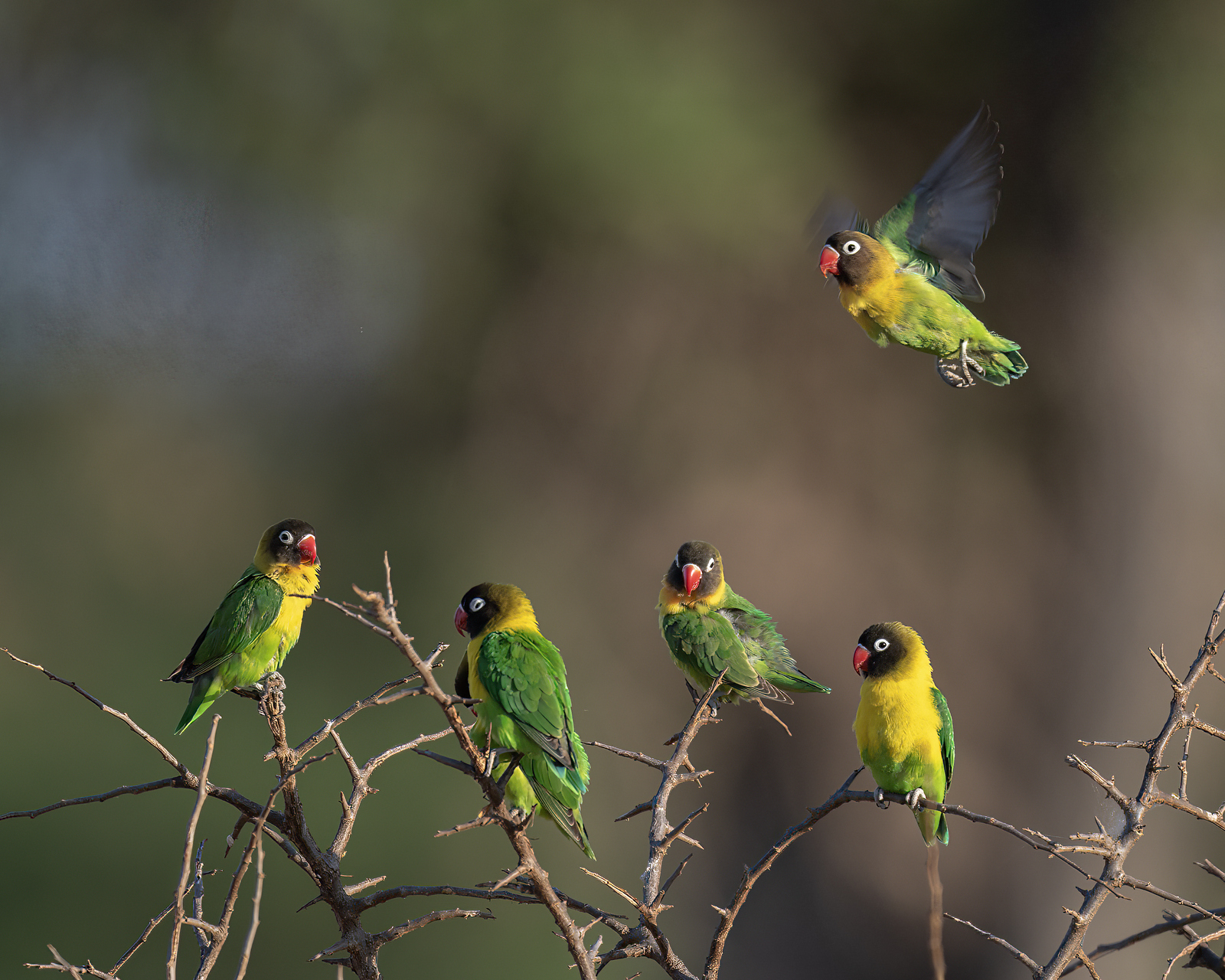
30
2024Poor Polly
Shot of the Month – April 2024
This month we visit with the gorgeous Yellow-collared Lovebird (YCL). I photographed this small group of birds in the Tarangire National Park in Tanzania. The YCL, also known as the masked lovebird or the eye-ring lovebird is a small type of parrot.
There are about 410 species of parrots and most are found in tropical and subtropical parts of the world. Parrots have strong curved beaks, an upright stance, and clawed feet. Of this large group of birds, only nine are in the lovebird genus.
The YCL is a colorful explosion of greens and yellows with a black head, bright red beak, and white eyerings. Lovebirds get their name from their affectionate ways. You can often find them sitting together for long periods as they get, well, all luvvy-duvvy with their mate. They are very social birds, very affectionate, and form strong monogamous pair bonds.
Humans are fascinated with Lovebirds, and their parrot brethren, and they are popular pets.
Sadly, humans are loving these birds to death. How bad could it be? Let’s break it down:
- One-third of all parrot species are threatened with extinction due to the pet trade, hunting, habitat loss, and competition from invasive species.
- As of 2021 about 50 million parrots (half of all parrots on the planet) live in captivity (cages) with most being pets in people’s homes. Every year over 16 million parrots are traded in captivity.
- The Fischer’s Lovebird (looks just like the YCL but with an orange head) was the most trafficked bird species in the world through the 1980s and not surprisingly their population plummeted 30% since the 1970s. Only 200,000 to 1 million birds remain in the wild.
- Somewhat encouragingly many countries now forbid the trade of exotic birds. The US was the largest importer of wild birds until 1992 when it finally passed the Wild Bird Conservation Act (WBCA). The European Union didn’t pass its ban on importation of wild-caught birds until 2007! Despite these efforts, the illegal trade of parrots and other birds is still thriving. For example, approximately 2 million Fisher’s Lovebirds were captured in the wild and traded illegally between 1976 and 2016. Lovebirds are often given as Valentine’s Day gifts…sigh….
- Finding it increasingly difficult to secure wild birds the pet trade industry shifted to breeding birds for the ever-growing demand for feathered pets. Think puppy mills, with all the horrors that go with that, but for birds. Industrialized operations often house hundreds of birds in rows of barren cages and deplorable living conditions. Parrots are highly intelligent and such conditions can cause the birds severe mental and physical impairment and trauma.
- Parrots can be very affectionate and cute when young but if not raised and trained properly can become aggressive and may bite causing serious injury. After a few months, many buyers find the demands of caring for a bird to be too much leading to parrots being surrendered and rehomed FIVE times before finding their final home or dying prematurely from neglect and abuse. Parrots require an enormous amount of care, attention, and intellectual stimulation to thrive and many owners are not ready or able to meet these demands leading to traumatic lives for the parrots.
A common problem is that large parrots that are cuddly and gentle as juveniles mature into intelligent, complex, often demanding adults who can outlive their owners, and can also become aggressive or even dangerous. Due to an increasing number of homeless parrots, they are being euthanised like dogs and cats, and parrot adoption centres and sanctuaries are becoming more common. Parrots do not often do well in captivity, causing some parrots to go insane and develop repetitive behaviours, such as swaying and screaming, or they become riddled with intense fear. Feather destruction and self-mutilation, although not commonly seen in the wild, occur often in captivity
Lovebirds and parrots have complex dietary, social, intellectual, and emotional needs – placing them, often alone, in a barren cage, for 10-80 years (some parrots can live a LONG time) is cruel and unusual punishment.
“Polly want a cracker?”
F*&$ that! Polly wants to be left alone.
Until next month…..michael
Sources:
Animal Welfare Institute – Bird Trade
Freedom for Animals (Blog: LOVE BIRDS? IF YOU DO, LEAVE THEM IN THE WILD!)
Wikipedia – Yellow-collared Lovebird
Nikon D5, Nikon 600mm, 1.4 TC (850 mm effective), f/5.6, 1/500 sec, ISO 280,


Mini Menon
very informative article…the photo of the lone Fischer’s Lovebird is very cute….the last line of the article is the clincher though 🙂